| |

|
 |
Until the end of the seventeenth century there was little or no organized control of fire fighting in Britain. In villages and towns ‘fire parties’ – able-bodied locals – fought fires as best they could with the minimal means available to them. Around that time the first schemes of fire insurance were started and the insurance companies found it prudent to have squads of fire fighters to deal with fires in the properties they insured. Generally these operated only in the central or heavily built up parts of the bigger towns and cities. In London the confusion and inefficiency resulting from rivalry among the different companies’ fire fighters was eventually resolved in 1833 when ten of the more important companies pooled their resources to form the London Fire Engine Establishment. Its Chief Officer was a highly effective Scotsman, James Braidwood. Although the methods and equipment underwent continual improvement its shortcomings were exposed by the disastrous warehouse fire at Tooley Street in 1861 which burned out of control for two days and cost Braidwood’s life. A subsequent parliamentary inquiry led to the Metropolitan Fire Brigade Act 1865 under which, from 1st January 1866, the men, stations and equipment of the London Fire Engine Establishment were passed to the management of the Metropolitan Board of Works [MBW]. The Chief Officer of the new Metropolitan Fire Brigade [MFB] was the charismatic Eyre Massey Shaw, who over the next twenty-five years built up the MFB to a high state of efficiency and popularity. |
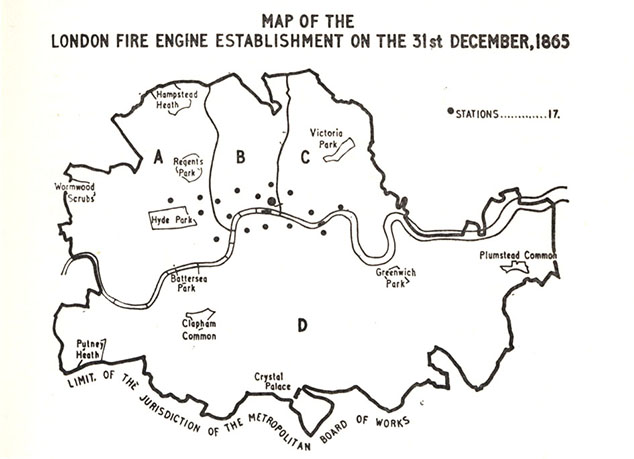 |
Disposition of the London Fire Engine Establishment as on 31st December 1865. The key letters indicate the four operational districts.
Source: London Fire Brigade (reproduced in Holloway, 1973, page 45) |
| |
The MFB’s area of operation was that of the MBW which in the 1860s effectively defined the built-up area of London. In the small towns and villages of the surrounding counties fire protection was gradually improving with the organization of volunteer fire brigades formed of public-spirited citizens and funded by public subscription or perhaps a wealthy local patron. The Public Health Act of 1875 gave local authorities powers to set up brigades which might be staffed by both full-time firemen and volunteers. The situation was further regularized by the Local Government Act of 1894 by which the existing urban sanitary districts and rural sanitary districts were replaced by urban districts and rural districts (see the section ‘Outer London Areas History’). These had wider responsibilities and brought fire protection much more closely under local authority control. The old manual pumps, powered by teams of men, were finally laid aside, to be replaced first by horse-drawn steam-powered pumps and later by self-propelled motor appliances. At the same time, the networks of fire hydrants under the streets were being greatly extended as the built-up area of Greater London increased. Many of the pavement hydrant covers, even today, bear the names of long-supplanted local authorities. (After the Second World War provision of fire hydrants passed to the Metropolitan Water Board or the appropriate district water company.)
Within London itself, the Local Government Act 1888 brought the end of the Metropolitan Board of Works on 20th March 1889. On the following day the Administrative County of London came into existence, its boundary being that of the MBW’s limit of jurisdiction. The newly-formed London County Council [LCC] became the controlling body for the MFB which was handed over as it stood, complete with its Chief, officers and men. It retained its former name, however, until changed to London Fire Brigade [LFB] by Act of Parliament in 1904. |
| |
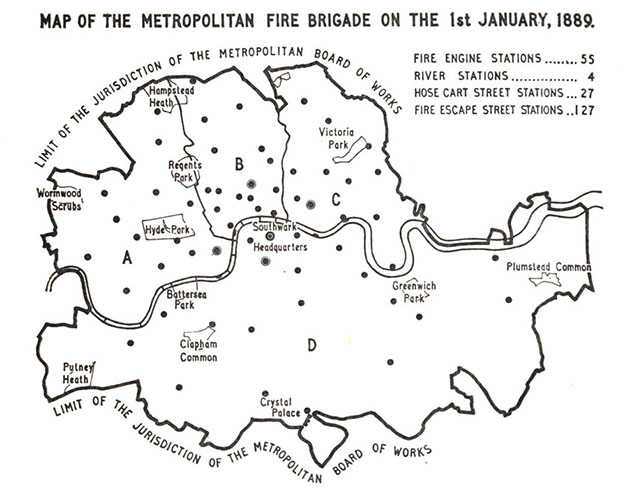 |
Disposition of the Metropolitan Fire Brigade as on 1st January 1889. The key letters indicate the four operational districts.
Source: London Fire Brigade (reproduced in Holloway, 1973, page 144) |
| |
In the early years of the twentieth century the LFB and the local authority brigades in the Greater London region continually improved their training methods and equipment. During the First World War all fire brigades in the Greater London area were, for the first time, co-ordinated for air raid purposes under the command of the Chief Officer of the LFB. In the years following, many new fire stations were built by the local authorities to meet the increasing requirements of a rapidly expanding population.
When war was again declared in 1939 all the local authority brigades were grouped into Regions. This co-ordination exposed the need for standardization, particularly of methods and equipment. In consequence and as a war measure the Fire Service was nationalized in 1941 and the National Fire Service [NFS] came into being. After the war the decision was made that control of fire brigades nationally should be vested in county councils and county boroughs. The provisions of the Fire Services Act 1947 came into force on 1st April 1948 when, in Greater London, the NFS was returned to the LCC and the councils of the adjoining counties. There was less autonomy than there had been pre-war, as the Home Office imposed national standards of fire risks, standard attendances to fires, the number of fire stations and the strengths of men and appliances.
The Royal Commission for Local Government in London (the Herbert Commission) produced its report in 1960. It recommended the establishment of an Administrative County of Greater London, within which there would be 32 London Boroughs and the continuing City of London, and whose overall governing body would be the Greater London Council [GLC]. It also recommended that there should be one fire brigade for the whole of Greater London. These proposals were accepted by the Government and embodied in the London Government Act 1963. On 1st April 1965 the Act came into force and the new London Fire Brigade came into existence, formed from the London and Middlesex Brigades in their entirety, the appropriate portions of the county brigades of Essex, Hertfordshire, Kent and Surrey, and the county borough brigades of Croydon, East Ham, and West Ham. At the same time its administration passed from the LCC to the GLC. |
| |
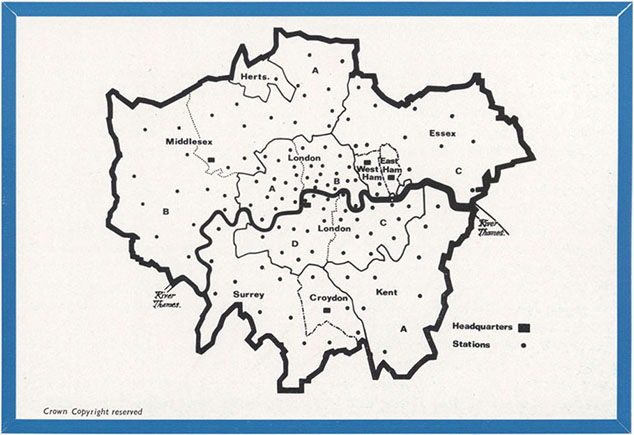 |
Diagram of Greater London showing constituent Brigades of the enlarged London Fire Brigade, 1965. The meaning of the key letters is unknown but they may designate operational divisions.
Source: London Fire Brigade, page 15. |
| |
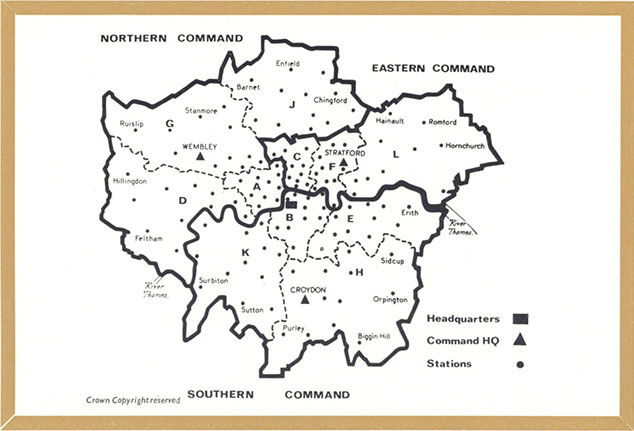 |
Diagram of London Fire Brigade area, 1966. The key letters indicate the Divisions within each of the three Command areas: Northern, Eastern, and Southern, as they were in 1966.
Source: London Fire Brigade, page 16. |
| |
When the GLC was abolished in 1986 the LFB was transferred to the London Fire & Civil Defence Authority. From 2000 the administering body has been the London Fire & Emergency Planning Authority. In one respect, though, there has been no change. Following the local authority reorganization of 1974, which did not involve London, nearly all local authorities in Britain dropped the term ‘fire brigade’ and adopted instead ‘fire service’ or, more recently, ‘fire and rescue service’. In London the brigade remains the London Fire Brigade. |
| |
FURTHER READING |
The above text has drawn freely on the following sources: |
| |
Anon, London Fire Brigade (Greater London Council, 1966) [272x223mm] |
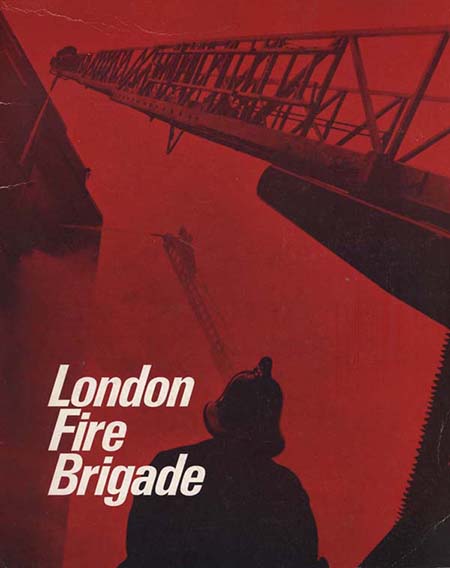 |
| |
Sally Holloway, London’s Noble Fire Brigades 1833-1904 (London, 1973) [224x145mm].
Image shows spine, front flap and dust wrapper. |
 |
| |
E W Jackson, London’s Fire Brigades (London, 1966) |
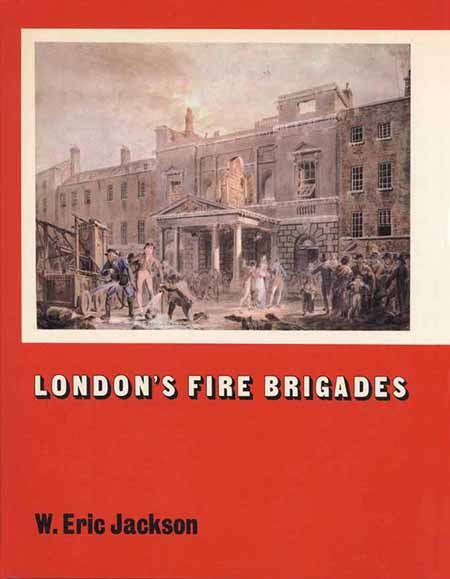 |
| |
John B Nadal, London’s Fire Stations (Jeremy Mills Publishing, 2006) [265x195mm] |
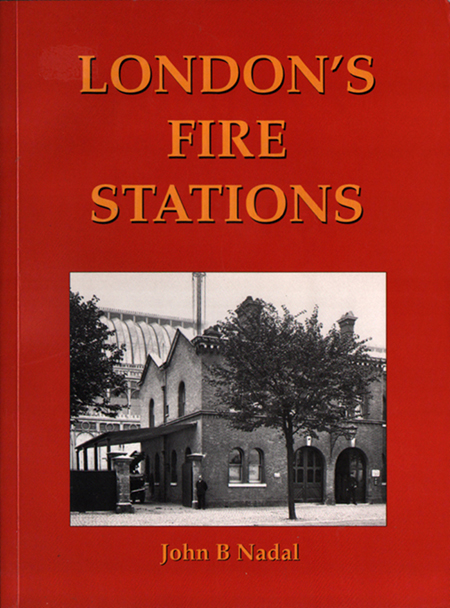 |
| |
Sir Clifford Radcliffe, Middlesex (new edition, London, 1954) [253x192mm].
Image shows title page. |
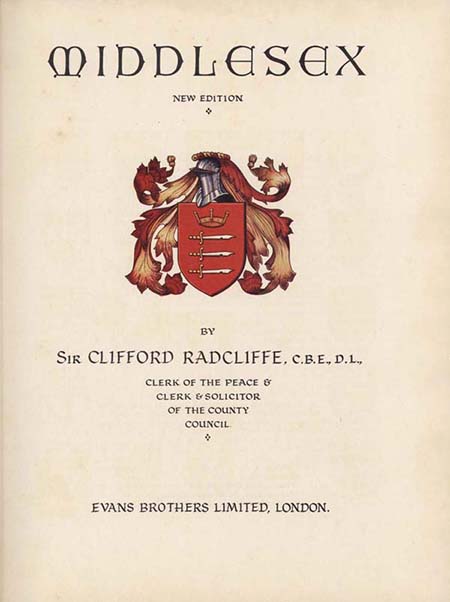 |
| |
Fire Station Information - Introduction
www.firestations.org.uk |
| |
| |
| < back to the main Street Furniture page |
| |
| * * * |
| |
|
|